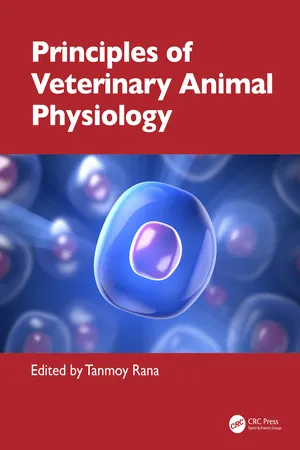
- English
- ePUB (mobile friendly)
- Available on iOS & Android
Principles of Veterinary Animal Physiology
About this book
This textbook for advanced graduate and postgraduate veterinary students, introduces animal behaviour, offering insights into its origins, cognitive aspects, communication, environmental influences, biological mechanisms, complex behaviours, adaptive strategies, and practical applications. The initial chapters present fundamental principles underpinning animal behaviour, elucidating the roles of evolution, genetics, and ecology. Subsequent chapters introduce the role of natural selection, habitat selection, and pheromones, alongside exploring conflicts, predator-prey dynamics, and the impact of domestication on behaviour. The book further delves into topics such as habitat selection, foraging strategies, predator-prey dynamics, and the effects of domestication on behaviour. It unravels the mysteries of animal defences, altruism, social dominance, territoriality, and the finely tuned art of food and habitat selection. Additionally, it covers the biological mechanisms governing behaviour, unearthing the roles played by neuroendocrinology, biological clocks, and genetics. Towards the end, the textbook examines the practical relevance of behavioural insights in veterinary science.
Key Features:
- Offers a comprehensive exploration of animal behaviour, encompassing a wide range of topics, from evolutionary principles to intricate behavioural patterns.
- Provides understanding of the origins of animal behaviour, including the roles of evolution, genetics, and ecology.
- Highlights the practical applications of behavioural insights in veterinary science and related fields.
- Delves into specialized areas of animal behaviour, such as innate behaviours, animal memory, pheromones, and cooperation.
- Explores how animals adapt to their environments, covering topics like foraging behaviour, predator detection, and self-defensive behaviours.
- Addresses the impact of environmental factors, hormones, and drugs on behaviour, offering a holistic view of animal responses to their surroundings.
Frequently asked questions
- Essential is ideal for learners and professionals who enjoy exploring a wide range of subjects. Access the Essential Library with 800,000+ trusted titles and best-sellers across business, personal growth, and the humanities. Includes unlimited reading time and Standard Read Aloud voice.
- Complete: Perfect for advanced learners and researchers needing full, unrestricted access. Unlock 1.4M+ books across hundreds of subjects, including academic and specialized titles. The Complete Plan also includes advanced features like Premium Read Aloud and Research Assistant.
Please note we cannot support devices running on iOS 13 and Android 7 or earlier. Learn more about using the app.
Information
Table of contents
- Cover
- Half-Title
- Title
- Copyright
- Contents
- Preface
- Acknowledgement
- About the Editor
- Chapter 1 General Introduction to Animal Physiology
- Chapter 2 Cellular Structure and Functions
- Chapter 3 Developmental Physiology
- Chapter 4 Physiology of the Cardiovascular System
- Chapter 5 Physiology of the Lymphatic and Immune System
- Chapter 6 Physiology of the Haematological System
- Chapter 7 Physiology of the Muscular System
- Chapter 8 Physiology of the Nervous System
- Chapter 9 Physiology of the Visual System
- Chapter 10 Physiology of the Auditory System
- Chapter 11 Physiology of the Somatosensory System
- Chapter 12 Physiology of the Olfactory System
- Chapter 13 Physiology of the Gustatory System
- Chapter 14 Physiology of the Bone
- Chapter 15 Physiology of the Digestive System of Monogastric Animals
- Chapter 16 Physiology of the Digestive System of Ruminants
- Chapter 17 Physiology of the Respiratory System
- Chapter 18 Physiology of the Excretory System
- Chapter 19 Physiology of the Endocrine System
- Chapter 20 Physiology of the Male Reproductive System
- Chapter 21 Physiology of the Female Reproductive System
- Chapter 22 Physiology of the Lactation System
- Chapter 23 Physiology of Growth
- Chapter 24 Environmental Physiology
- Chapter 25 Physiology of Aging
- Chapter 26 Experimental Physiology
- Index